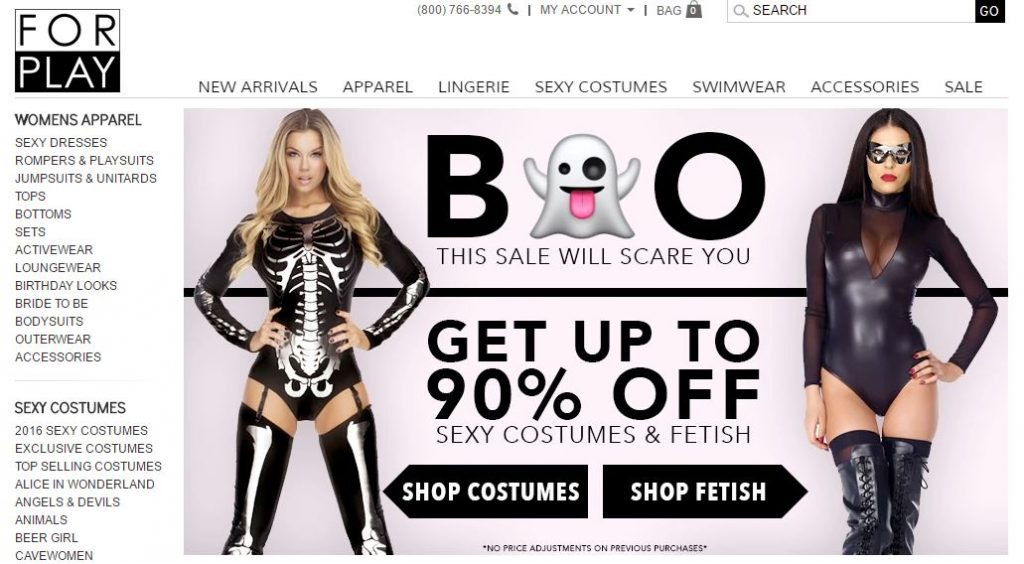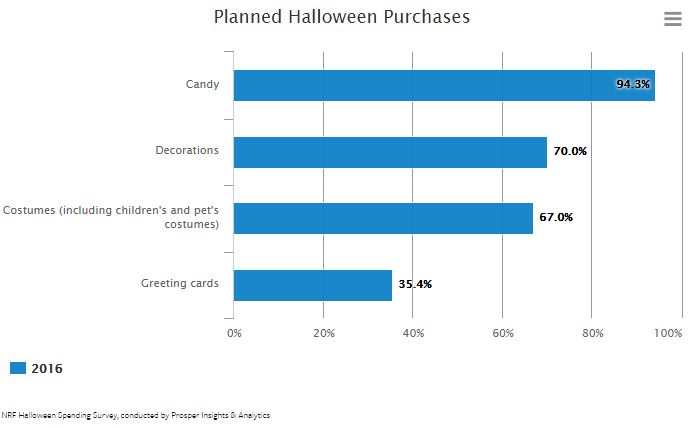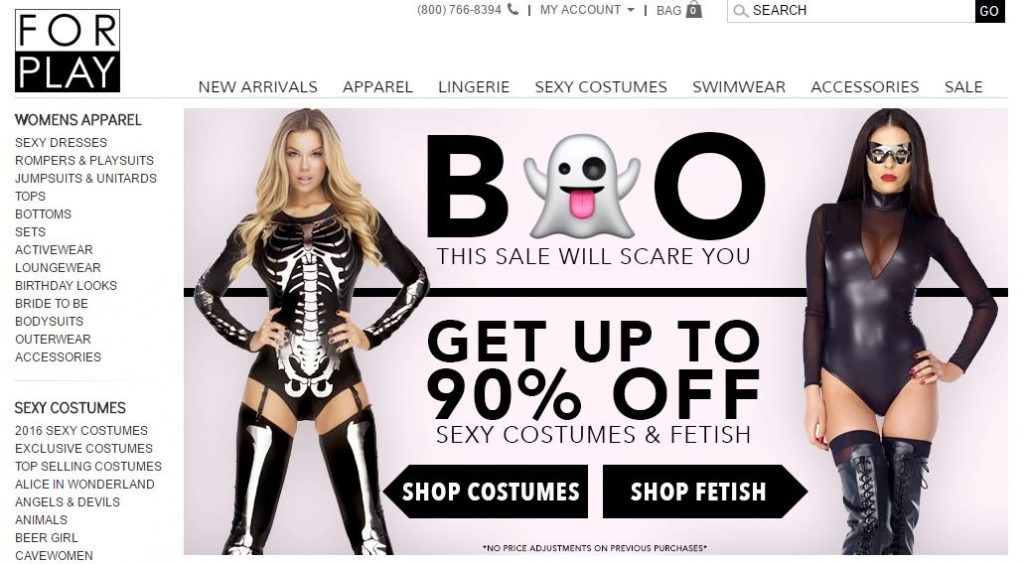CPC Strategy Increases Orders 280% For Halloween Costume Retailer

More than 171 million Americans plan to celebrate Halloween – spending an average of $82.93 on everything from costumes to candy and decor.
According to the National Retail Federation, total spending in the U.S. is expected to reach $8.4 billion, an all-time high – of that amount more than half will be spent on costumes.

From superheros to Disney characters, there is no shortage of costume ideas to choose from and as a result competition among retailers continues to increase each year – demanding a more sophisticated advertising strategy.
ForPlay Catalog, Inc., a sexy lingerie and costume retailer teamed up with CPC Strategy in September 2015 hoping to increase their revenue growth on Google Shopping.
In addition to revenue growth, ForPlay Catalog also wanted to increase their visibility on Google Shopping across all costumes in their feed and improve overall impression share for relevant searches.

Although it seemed like a ghostly and unattainable task to target impression share on key searches, CPC Strategy was able to exceed ForPlay Catalog’s expectations due to our unique ISO campaign implementation and CAPx technology.
 “We are very happy with the results of our Halloween campaign with CPC Strategy,” Cyrille Jan (Miguel) Delos Santos, Digital Marketing Manager at Forplay Catalog, Inc. said.
“We are very happy with the results of our Halloween campaign with CPC Strategy,” Cyrille Jan (Miguel) Delos Santos, Digital Marketing Manager at Forplay Catalog, Inc. said.
“They delivered beyond our expectations, stayed on top of our campaigns throughout our busiest season and were truly proactive about the changes happening with our consumers and sales in real-time. [Account Managers] Helen and Roman’s attention to detail is remarkable.”
Google Shopping Results from 2015 vs 2016 (first 25 days of October):
 Roman Fitch, Retail Search Manager at CPC Strategy added, “These results highlight the benefit of a long-term partnership and how it can lead to year over year improvements due to a better understanding of your business, and how we’re able to continuously improve and iterate on our strategy.”
Roman Fitch, Retail Search Manager at CPC Strategy added, “These results highlight the benefit of a long-term partnership and how it can lead to year over year improvements due to a better understanding of your business, and how we’re able to continuously improve and iterate on our strategy.”
1. Implemented ISO campaign™ Strategy
“In addition to breaking out campaigns by device (mobile vs desktop and tablet), we also segmented Shopping campaigns by intent,” Fitch said.
“For example, sexy vs. non-sexy Halloween terms, we placed more budget to “sexy” intent terms with higher bids, budget, and impression share targets. We also created an ISO Campaign targeting top generic searches to increase top of the funnel impression share on relevant terms.”

ISO campaigns™ leverage priority settings and negative keywords to isolate and allocate more aggressive bids and budget to certain high value searches.
This advanced strategy gives advertisers more control over which search queries their products show up for. It also allows them to isolate and dedicate budget to search queries that historically convert well.
It’s similar to how we think of text ad campaigns. With text ads, we can choose to set up our campaigns based on exact searches and bid higher and with more confidence because we know these are exact searches we want to go after.
With ISO campaigns™, although we can’t target keywords directly, we can leverage negative keyword lists in an alternative campaign and then utilize the priority settings so that searches funnel into the right campaign.
To learn more about ISO Campaigns, check out our blog post.
2. Leveraged Our CAPx Bidding Rules Technology
Unfortunately, a lot of advertisers don’t utilize rule-based bidding strategies to optimize their Google Shopping campaigns as much as they should.
Many times, advertisers think Shopping is just a ‘set it and forget it’ type of management but whenever we do an audit of a Shopping campaign, we usually end up finding a lot of wasted spend and the potential for opportunity.
What has worked really well for our clients is to start with a set of bid rules for introducing ourselves to the product catalog. And although every catalog is going to work a little bit differently, over time what we can do (as a result of rule-based bidding) is better understand the way inventory and products adjust to bid changes or manual actions we are taking.
In the case of ForPlay Catalog, using CAPx technology, we were able to create specific bidding rules per device. In particular, more granular bidding rules on mobile through CAPx helped us push for huge YoY increases on mobile shopping:
To learn more about CAPx Technology, check out our blog post.
3. Special Offers
According to Fitch, we also used special offers to highlight promotions and improve CTR.
Merchant Promotions – also called special offers – give retailers an opportunity to highlight their products and better their chances of click through rate and conversion.
Benefits of using Merchant Promotions include:
4. RLSA & Customer Match
“Lastly, we leveraged RLSA to stay in front of users coming from top funnel shopping campaigns, and utilized Customer Match to get in front of purchasers from last Halloween on shopping,” Fitch said.
Remarketing lists for search ads (RLSA) is a feature that allows retailers to customize their search ad campaigns for people who have previously visited their site, and tailor their bids and ads to these visitors when they’re searching on Google.
When potential customers leave a site, remarketing lists help retailers connect with those shoppers while they continue to search for what they need on Google.
Thanks to the introduction of Customer Match for Google Shopping – businesses like For Play Catalog can focus campaigns on their highest-value audiences – including previous purchasers, rewards members, newsletter subscribers, or local in-store shoppers.
Customer Match is a feature aimed to re-engage loyal customers as they shop on Google.
Customer Match for Shopping allows advertisers to adjust bids across various segments of their known customers. Advertisers upload a list of email addresses into AdWords, that are matched to signed-in users on Google. Then they can create a remarketing list to reach these customers across campaigns.
To learn more about Customer Match, check out our blog post.
